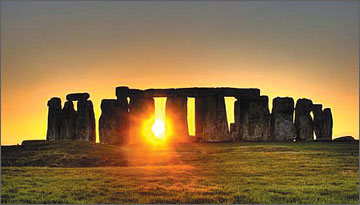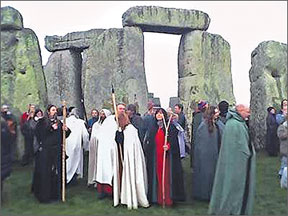New structure found near Stonehenge
Chamari Senanayake
Stonehenge is probably the most important prehistoric monument
in the whole of Britain and has attracted and mesmerized visitors
from all over the world. The site and its surroundings were added to
UNESCO’s list of World Heritage Sites in 1986. It stands as a
timeless monument to the people who built it, and forever remains a
mystery to, who exactly built it, how, and for what purpose.
|

The mysterious Stonehenge during the sunset |
The Stonehenge that we see today is the final stage that was
completed about 3500 years ago, but first let us look back 5000 years.
The first Stonehenge was a large earthwork or Henge, comprising a ditch,
bank, and the aubrey holes, all probably built around 3100 BC.
Shortly after this stage Stonehenge was abandoned, left untouched for
over 1000 years. The second and most dramatic stage of Stonehenge
started around 2150 BC. Some 82 bluestones from the ‘Preseli’ mountains,
in south-west Wales were transported to the site. This astonishing
journey covers nearly 240 miles.
The third stage of Stonehenge, about 2000 BC, saw the arrival of the
Sarsen stones, which were almost certainly brought from the Marlborough
Downs about 25 miles north of Stonehenge. The largest of the Sarsen
stones transported to Stonehenge weigh 50 tonnes and transportation by
water would have been impossible, the stones could only have been moved
using sledges and ropes.
It would have taken 500 men to shift one Sarsen stone, with another
100 in front to lay rollers and drag them 25 miles south to Stonehenge.
The final stage took place soon after 1500 BC when the bluestones were
rearranged in the horseshoe and circle that we see today.
Scientists scouring the area around Stonehenge said on 23rd of July
that they have uncovered a circular structure only a few hundred meters
from the world famous monument. It is a wooden version of Stonehenge and
is described as the most exciting find of its kind in a lifetime. This
is a vast circle of wooden posts up to 19ft tall, surrounded by a ditch
and bank.

Druids in cloaks dressed in ancient styles during
a ceremony near Stonehenge |

Modern day Druids carry out ceremonies near Stonehenge as
traditional pagan practice |
It was built around the same time as its big sister and may have been
used for ritual Bronze Age feasts, experts say. Just like Stonehenge,
its entrances are aligned with the summer solstice, allowing the sun’s
rays to enter the centre of the circle on Midsummer’s Day.
Prof Vince Gaffney, of Birmingham University who found the new circle
using ground-based radar believes it was used at the same time as the
5,000-year-old stone They discovered a 80 foot wide bank and ditch with
entrances at to the north-east and south-west - the same orientation as
Stonehenge.
It lies 980 yards to the north west of Stonehenge. Inside the ditch
is a circle of 24 holes, three foot across - large enough to support 24
wooden posts up to 19 ft high. Right in the centre of the henge is a
burial mound around 40 feet across. Archaeologists won’t be able to
accurately date the site without an excavation.
Although antiquarians have been poking around the area since the 18th
century, excavations are now tightly restricted. Research done in recent
years shows that Stonehenge was at the centre of a network of circles,
ditches, ceremonial roads and burial grounds. Within a few miles,
archaeologists have discovered around 1,200 Bronze age monuments.
The landscape around Stonehenge is home to a staggering 1,200 Bronze
Age henges, standing stones, burial mounds and ceremonial roads.
Geoffrey of Monmouth, the 12th century historian, told how the stones
were brought from Mount Kilarus in Ireland to England by Merlin and
Knights, linking Stone-henge to the Arthurian Legend.
The timber henge would have been constructed and modified at the same
time as its more famous relative, and probably had some allied
ceremonial or religious function, exactly what kind of ceremonies those
were is unclear. The new henge joins a growing complex of tombs and
mysterious Neolithic structures found across the area.
The closest equivalent is probably the nearby Wood henge, a monument
once composed of six rings of wooden posts enclosed by an earth
embankment. Excavations there in the 1970s revealed the body of child
whose skull had been split buried at the centre of the henge – hinting
at the possibility of human sacrifice.
Bronze Age farmers seem to have avoided cultivating crops there,
although no one is sure quite why. The team is still in the early stages
of its work, having surveyed only about four square kilometers (1.5
square miles) of the 16 square kilometers (six square miles) it
eventually plans to map.
The survey is being led by the University of Birmingham and the
Austria-based Ludwig Boltzmann Institute for Archaeological Prospection
and Virtual Archaeology, with support from other institutions and
researchers from Germany, Norway and Sweden. |



